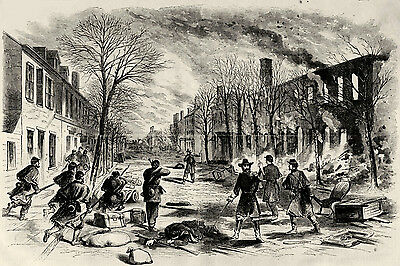-40%
Civil War Battle of Fredericksburg Virginia Union Army Fighting in the Streets
$ 23.76
- Description
- Size Guide
Description
Antique Print DescriptionThis is an original engraved print titled,
"Our Soldiers In The Streets Of Fredericksburg. Drawn By Mr. A. R. Waud."
It was published in a Civil War era Harper's Weekly, 3 January, 1863. Read a selection of the descriptive text below. You may be interested in
our other listings
on eBay.
Title:
Our Soldiers In The Streets Of Fredericksburg.
-
Drawn By Mr. A. R. Waud.
Artist/Photographer:
Mr. A. R. Waud
Publisher:
Harper's Weekly
Medium Used:
Wood Engraving
Year:
January 3, 1863
Size:
Full Dated Page - Measuring 11" x 16";
measures
9" x 13.5"
with ample
margins for framing
Condition:
Very Good
Description:
Original Authentic Civil War Era Antique Print
From the Harper's...THE STREETS OF FREDERICKSBURG
Mr. Waud's picture is well described in the following extract from the Herald correspondence: No one could better understand what war is than by taking a stroll through the streets of the almost destroyed city of Fredericksburg. Turn where you will and your eye meets some evidence of the terrific fire that was hurled from our guns into the streets and dwellings. Nothing appears to have escaped. Roofs, walls, fences, trees, and chimneys are perforated; and in some instances to such an extent that the side of a house presents the appearance of a huge pepper-box, the holes are so numerous and regular, while immediately beside it are the smoking remains of what once was a stately dwelling.
Some of the houses on the river-front are completely torn to pieces, and as one turned from one street to another the question would naturally rise to his mind?How could any thing remain here and live? And yet, strange to say, people did remain, and I have yet to learn of any casualty to those who did so. Quite a number, after the fashion of the citizens of Sharpsburg, took their families into the cellars of their houses, and there remained in safety.
In one house I found about a dozen ladies and a few gentlemen. When we crossed they emerged from their place of refuge and received us with open arms. The majority of them are good Union people, and are not unknown to a number of our officers, who were here some months ago. I had but little opportunity of speaking to theta.
In all, I suppose some fifteen or twenty families remained, and I can not see what saved them all from one common destruction. Instead of looking for a house that had been struck, the difficulty is to find one that has not suffered more or less. The streets are piled with bricks from the chimneys, and in fact the city looks as if it wanted to be made all over again. The churches have wonderfully escaped, having been but partially injured, and the steeples are nearly as good as ever. The Bank of the State of Virginia was burned down...
Frequently Asked Questions
Are those odd lines on the image a defect in the print?
Antique prints often have faint vertical or horizontal lines visible. Rather than a defect, they are a fascinating historical artifact of the popular engraving process employed by newspapers at the time of the Civil War? During the war, newspaper publishers needed a method where they could get the illustrations produced by newspaper artists in the battlefield to the American public as quickly as possible.
To do this, the illustration was divided into sections usually two inches square. Double page prints were divided into as many as 40 sections. The section was traced onto a wood block. Engravers cut into the wood with various tools creating a mirror image of their section of the illustration. The blocks were then screwed together, recreating the original illustration. This would then be inked and stamped onto the newsprint. The lines on the image above are a result of where the blocks of wood were joined together.
Will my antique print deteriorate?
Before 1870, newspapers were not made from wood pulp as they are today. Instead, they were printed on a sturdy paper made by pulping linen rags. These rags came from clothing and ship sails. Because this kind of paper contains very little acid, your antique print could easily retain its appearance for many years into the future, if handled properly.
Why do people purchase antique prints and maps?
Antique prints and maps portray a moment in history. Because they represent a broad range of subjects, they are particularly useful when looking for a unique gift. Interior design has become a huge market for antique prints. From small framed botanicals to large Civil War maps, from large framed old city views to a collection of framed Harper's satirical cartoons, antique prints provide a world of design possibility. If properly framed, antique prints and maps can be preserved for many decades.
Is this item really authentic or just a reproduction?
You can have confidence that the item you purchase is guaranteed to be an original and not a modern day reproduction of any kind.
Can I return an item I purchase?
All purchases come with a 100% satisfaction guarantee.









